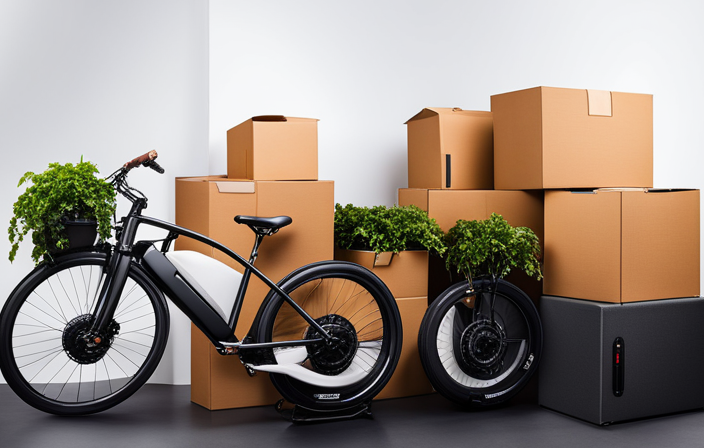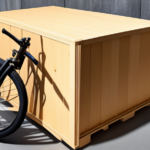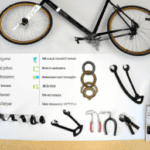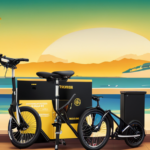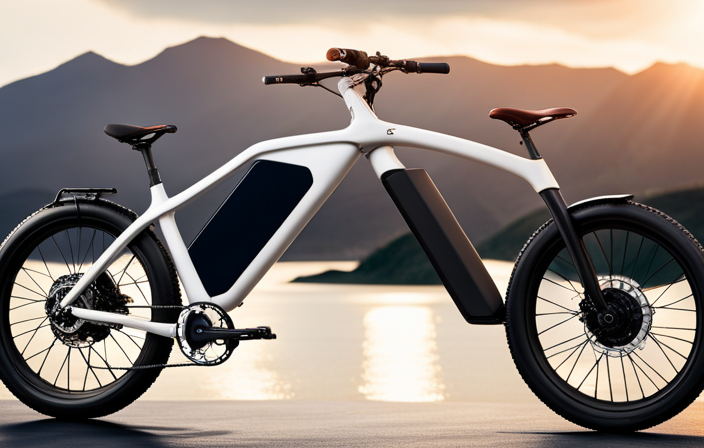Were you aware that the electric bike market worldwide is expected to hit $38.6 billion by 2025?
With the increasing popularity of electric bikes, it’s important to know how to ship them safely and securely.
Whether you’re selling or sending an electric bike, this comprehensive guide will provide you with the knowledge and expertise to navigate the packaging, shipping, and handling process.
From understanding shipping regulations to protecting the battery, we’ve got you covered.
So let’s dive in and learn how to ship an electric bike with confidence.
Key Takeaways
- Research import duties and taxes
- Prioritize protection of delicate components
- Provide tracking updates
- Assess delivery routes
Assessing Packaging Requirements for Electric Bikes
You’ll need to assess the packaging requirements for your electric bike to ensure it arrives safely at its destination.
Start by considering the packing materials you’ll need. Electric bikes are typically large and heavy, so you’ll want to use sturdy materials such as foam padding, bubble wrap, and cardboard boxes to protect the bike from any potential damage during transit.
Additionally, be mindful of weight restrictions imposed by shipping carriers. Electric bikes can be quite heavy, so make sure you stay within the weight limits to avoid any additional fees or delays.
Once you have assessed the packaging requirements and gathered the necessary materials, you can move on to choosing the right shipping provider, which we’ll discuss in the next section about finding reliable transportation options.
Choosing the Right Shipping Provider
When choosing the ideal shipping provider, make sure to consider their reputation and track record. Look for a company with experience in shipping electric bikes and a proven track record of successful deliveries. Check customer reviews and ratings to get an idea of their reliability and customer satisfaction.
Additionally, consider their shipping rates and delivery time. Compare different providers to find the best balance between affordability and efficiency. Some providers may offer lower rates but longer delivery times, while others may charge more for faster shipping. It’s important to find the right balance that suits your budget and timeline.
Understanding shipping regulations for electric bikes is crucial to ensure a smooth and hassle-free shipping process. Keep reading to learn more about the necessary regulations and requirements.
Understanding Shipping Regulations for Electric Bikes
Make sure to familiarize yourself with the shipping regulations for electric bikes to ensure a smooth and hassle-free transport process.
When shipping an electric bike, there are specific restrictions you need to be aware of. Firstly, check if the shipping provider allows the transportation of electric bikes. Some providers may have restrictions due to the lithium-ion batteries.
Secondly, battery transportation regulations are crucial to follow. Ensure that the battery is properly packaged to prevent any damage or leakage during transit. Additionally, check if there are any restrictions on the size or weight of the package to avoid any issues during shipping.
Once you understand these shipping regulations, you can move on to the next section about securing and protecting the battery during transportation.
Securing and Protecting the Battery
To ensure a safe and worry-free transport, it’s essential to properly secure and protect the battery during transportation. The battery is the most critical component of an electric bike, and it needs to be handled with utmost care.
One of the key steps in securing the battery is using protective packaging. This can include foam padding, bubble wrap, or a sturdy box specifically designed for battery transportation. Make sure the battery is tightly secured within the packaging to prevent any movement during transit.
Additionally, it’s important to label the package as containing a lithium-ion battery to comply with shipping regulations.
Once the battery is securely packaged, you can move on to the next step of disassembling and packing the electric bike, ensuring that each part is adequately protected for a smooth and damage-free shipment.
Disassembling and Packing the Electric Bike
Once you have securely packaged the battery, it’s time to disassemble and pack the e-bike for shipment. When disassembling, start by removing any accessories such as mirrors, lights, or baskets. Secure loose parts by using zip ties or bubble wrap to prevent damage during transit. Next, fold down the handlebars and remove the pedals. Lower the seat and secure it with tape or a rubber band. To protect the frame from scratches, wrap it with foam or bubble wrap. Place all disassembled parts, such as the pedals and accessories, in a separate box or bag and label them accordingly. When packing the bike, use a sturdy cardboard box and fill any empty spaces with packing material like foam or bubble wrap. Once the bike is properly packed, you can move on to the reassembling process. This involves carefully following the manufacturer’s instructions to put the bike back together. Finally, transition into the subsequent section about properly labeling the package by mentioning the importance of ensuring the bike is securely packed for safe transportation.
Properly Labeling the Package
Label the package correctly to ensure that it can be easily identified and handled during transit. Proper labeling is essential when shipping an electric bike to avoid any confusion or mishandling.
Start by clearly indicating the sender’s and recipient’s addresses on the package using a permanent marker. Additionally, it is crucial to include shipping instructions such as ‘fragile’ or ‘this side up’ to prevent any damage. Make sure to affix any required shipping labels or stickers, such as those provided by the shipping carrier.
Following these steps will help ensure that your package is properly labeled and ready for shipment. Once you have completed this step, you can move on to the next section about selecting the appropriate shipping insurance to protect your electric bike during transit.
Selecting the Appropriate Shipping Insurance
Choosing the right insurance coverage is crucial when sending your package to ensure protection during transit. When shipping your electric bike, it’s important to evaluate the coverage options provided by different shipping carriers. Take the time to carefully review the insurance policies and compare prices to find the best fit for your needs.
Evaluate the coverage limits, deductibles, and exclusions to ensure that your electric bike is adequately protected. While comparing prices, keep in mind that the cheapest option may not always provide the most comprehensive coverage.
Once you have selected the appropriate shipping insurance, the next step is to research international shipping options, which will allow you to send your electric bike overseas with ease.
Researching International Shipping Options
When researching international shipping options, you should consider the different carriers available for sending your package overseas. It is important to compare the services offered by various carriers, such as UPS, FedEx, and DHL, to determine which one best meets your needs.
Take into account factors such as international shipping costs, transit times, and reliability. Additionally, consider the customs clearance process of each carrier. Some carriers may have more experience or resources in navigating the complex customs procedures of certain countries, which can help ensure a smoother delivery process.
Once you have selected a carrier, you can move on to the next step of tracking and monitoring the shipment, which will allow you to stay updated on its progress and ensure its safe arrival.
Tracking and Monitoring the Shipment
After selecting a carrier, it’s important to track and monitor your international shipment to ensure its safe arrival. Tracking accuracy and real-time updates are crucial in this process. By keeping a close eye on your shipment, you can stay informed about its progress and quickly address any potential issues that may arise. To help you visualize the importance of tracking, here is a table that highlights the benefits of real-time updates:
| Benefits of Real-Time Updates |
|---|
| 1. Peace of mind |
| 2. Timely problem resolution |
| 3. Improved customer service |
| 4. Ability to plan ahead |
By utilizing these features, you can ensure the security and efficiency of your electric bike shipment. Now, let’s move on to the next section, which will discuss dealing with customs and import duties, ensuring a smooth delivery process.
Dealing with Customs and Import Duties
Now that you’ve successfully tracked and monitored the shipment of your electric bike, it’s important to be prepared for any potential customs delays and understand the import regulations involved.
Dealing with customs can sometimes be a complex process, but with the right knowledge, you can navigate it smoothly. Make sure to research and familiarize yourself with the specific import duties and taxes imposed by the destination country. Be prepared to provide necessary documentation, such as proof of purchase and a detailed description of the bike.
Understanding the regulations and requirements beforehand will help you avoid unnecessary delays and ensure a seamless customs clearance process. By being proactive and well-informed, you can ensure that your electric bike arrives at its destination without any hiccups.
Now, let’s move on to the next section about handling returns and exchanges.
Handling Returns and Exchanges
To handle returns and exchanges, it’s important to understand the policies and procedures set by the seller or retailer. Familiarize yourself with their return policy, including any time limits or conditions for returns.
When a customer contacts you with a complaint, be responsive and empathetic. Listen to their concerns and try to find a satisfactory solution, whether it’s a replacement, refund, or exchange.
It’s also crucial to manage your inventory levels effectively. Keep track of the number of electric bikes available and update your stock regularly. This will help prevent any delays or issues with fulfilling return requests.
As you handle returns and exchanges smoothly, you can seamlessly transition into the next step of shipping accessories and spare parts.
Shipping Accessories and Spare Parts
Shipping accessories and spare parts is crucial for customer satisfaction and business operation. Prioritize protecting delicate components with bubble wrap, foam, or cushioning materials. Use sturdy boxes or containers to prevent damage. Compare shipping rates from different carriers to find affordable options without compromising quality. Some carriers offer discounted rates for bulk shipments or regular customers. Communicate with the recipient for a seamless delivery experience and package tracking.
Communicating with the Recipient
Make sure you communicate with the recipient of your package to ensure a smooth delivery experience and allow them to easily track their shipment. Here are some important tips to follow:
-
Provide tracking updates: Keep the recipient informed about the progress of their electric bike shipment. Share the tracking number and any relevant tracking links so they can monitor the status themselves.
-
Communicate any potential delays: If there are any unexpected delays or issues with the delivery, promptly inform the recipient. Transparency is key to maintaining trust and managing expectations.
-
Be responsive: Encourage the recipient to reach out if they have any questions or concerns. Respond promptly to their inquiries and provide clear and helpful information.
-
Offer support: Ensure the recipient knows they can rely on you for assistance throughout the shipping process. Address any issues that may arise promptly and professionally.
By effectively communicating with the recipient, you can help them stay updated and address any potential communication delays, ensuring a successful delivery experience.
Now let’s move on to ensuring safe delivery and handling of the electric bike.
Ensuring Safe Delivery and Handling
To ensure the safe delivery and handling of your electric bike, it is crucial to assess delivery routes and plan accordingly. By carefully examining the route, you can identify potential obstacles or hazards that might pose a risk to your bike during transit. Additionally, considering the timing of the delivery is essential to ensure it arrives on time. This involves coordinating with the shipping company and selecting a delivery option that aligns with your desired timeline. By being proactive in assessing delivery routes and ensuring timely delivery, you can minimize the chances of any mishaps or delays. Now that you understand how to ensure safe delivery and handling, let’s move on to the next section where we will discuss troubleshooting common shipping issues.
Troubleshooting Common Shipping Issues
When encountering common issues during the transportation process, it’s important to know how to troubleshoot them effectively.
One common issue you may face when shipping an electric bike is delivery delays. If your package is taking longer than expected to arrive, start by tracking the shipment online to get real-time updates. If there are any issues or delays, contact the shipping company to inquire about the status and ask for a resolution.
Another issue you might encounter is handling damaged packages. If your electric bike arrives with any visible damage, document it with photographs and contact the shipping company immediately. They will guide you through the claims process and help you seek compensation for any damages. Remember to keep all packaging materials as they may be needed for inspection.
Frequently Asked Questions
Can I ship an electric bike internationally?
Yes, you can ship an electric bike internationally. However, it’s important to consider the shipping costs and customs clearance procedures.
Shipping costs can vary depending on the destination and the size/weight of the bike. Customs clearance is necessary as it involves declaring the bike and paying any applicable duties or taxes.
It’s advisable to research shipping companies that specialize in international bike transportation to ensure a smooth and hassle-free process.
What should I do if the battery of my electric bike gets damaged during shipment?
If your electric bike’s battery gets damaged during shipment, don’t panic.
Firstly, check if you have shipping insurance that covers such damages. If you do, contact the shipping company immediately and file a claim.
Provide them with all the necessary documentation, including proof of the damage. They will guide you through the process of getting compensation for the damaged battery.
Remember, prompt action and communication is key in resolving this issue.
How do I properly label the package for shipping an electric bike?
To properly label the package for shipping an electric bike, ensure you follow the necessary guidelines.
Begin by securely packaging the bike using proper materials to protect it during transit.
Then, affix labels indicating the contents of the package, including ‘Electric Bike’ and any necessary handling instructions.
Additionally, make sure to include the recipient’s address and your return address.
Lastly, consider the shipping costs and choose a reliable and cost-effective shipping method that meets your requirements.
What are the shipping regulations for electric bikes in my country?
To ship an electric bike in your country, it’s important to be aware of the shipping regulations. These regulations vary depending on the country, so it’s crucial to do your research.
Check with the local shipping authorities or courier services to understand the specific requirements for shipping an electric bike. This includes packaging requirements to ensure the bike is properly protected during transit.
Additionally, inquire about any applicable shipping fees that may be associated with sending an electric bike.
What should I do if the electric bike arrives damaged or with missing parts?
If your electric bike arrives damaged or with missing parts, it can be frustrating. But fear not, there are steps you can take to resolve the issue.
Start by documenting the damage or missing parts with photos and detailed descriptions.
Then, contact the shipping company and file a claim for the damaged electric bike.
To prevent damage during shipment, ensure the bike is properly packaged with sufficient padding and secure attachments.
Conclusion
In conclusion, shipping an electric bike may seem like a daunting task, but with the right knowledge and preparation, it can be easily accomplished. Remember to assess packaging requirements, choose a reliable shipping provider, and understand shipping regulations.
Securing and protecting the battery is crucial, and disassembling and packing the bike properly is key. Don’t forget to ship any accessories and spare parts, and communicate with the recipient throughout the process.
By following these steps, you can ensure a safe and successful delivery.
Were you aware that the electric bike market worldwide is expected to hit $38.6 billion by 2025? Stay informed and keep riding!
